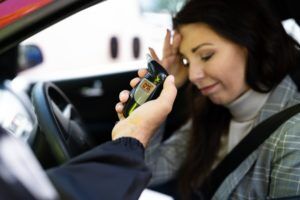
DUI breath testing machines detect alcohol for about 12 to 24 hours after you consume your last drink. That said, if you metabolize alcohol quickly, it is possible a breathalyzer will not detect alcohol after 12 hours. 1
Factors that influence the speed at which your body metabolizes alcohol include:
- weight/body fat percentage,
- height,
- genes,
- stress levels,
- overall health,
- whether you are hydrated,
- rate of alcohol consumption,
- age, and
- gender.2
As to the last two factors, keep in mind that you will likely metabolize alcohol at a slower rate as you grow older. Further, males generally tend to metabolize alcohol at a faster rate than females.
Also note that different beverages contain different concentrations of alcohol: For instance, wine contains less than a shot of vodka. Drinks with more alcohol are slower to leave your body.
Drinking on an empty stomach could also speed up the alcohol being metabolized. Food tends to slow the process.
1. Is alcohol on your breath evidence of DUI?
Police who smell alcohol on your breath during a traffic stop may suspect you of drunk driving when in fact it has been a long amount of time since your last alcoholic drink.3
Therefore alcohol on your breath is usually not enough evidence, on its own, for a police officer to arrest you for DUI/DWI. Law enforcement make their determination after:
- observing your speech and demeanor;
- administering a roadside breathalyzer test (which is usually optional); and
- scoring your field sobriety tests.
2. What does a breathalyzer measure?
A breath test calculates your blood alcohol content/concentration, or your BAC.
You will usually see blood alcohol levels expressed as percentages. As the percentage increases, you will have a higher BAC.
Note that 49 states say you are guilty of drunk driving if you have a BAC of .08% or higher. Utah is the only state where the legal limit for a DUI is .05%.4
In some states, commercial drivers commit DUI by driving with a BAC of .04% or higher. Meanwhile, under-21 drivers can usually be arrested with a BAC of only .02%.
3. How do breathalyzers work?
When you drink any amount of alcohol, it travels through your digestive system and into your small intestine. The alcohol then diffuses into your bloodstream.
Once in your blood, the alcohol circulates throughout your body and eventually reaches the capillaries in your lungs. That is why some alcohol gets released when you exhale.
After you exhale into a breathalyzer, the machine takes your breath sample. Fuel cell sensors in the breathalyzer creates electricity that shows the amount of alcohol present. Then the sensor – using infrared spectroscopy – measures the alcohol with light.
Afterwards, the sensor’s data is converted by a microprocessor to your “BrAC,” short for breath alcohol content. Finally, this BrAC number is converted into a BAC number (short for blood alcohol content, as discussed above).
4. What about other types of tests that detect alcohol?
If you are arrested for drunk driving, you typically have the choice between taking a breath or blood test. Blood tests can detect alcohol for up to 12 hours after your last drink.
Note that a urine test can detect alcohol for up to five days after your last alcoholic beverage. Finally, a hair follicle test can detect the presence of alcohol for up to 90 days after alcohol consumption.5
5. Are breathalyzers accurate?
It depends on how well and how often the machine is maintained and calibrated. Also, breathalyzers can be tricked into returning a falsely high BAC by:
- residual mouth alcohol (such as from mouthwash or regurgitation after a burp),
- GERD,
- acid reflux,
- a high protein diet, or
- being dehydrated.
Even environmental factors such as weather could potentially affect breathalyzer results.
Another obstacle is that some people are unable to produce an adequate breath sample. In these cases, police may insist on you taking a blood test.
Additional Reading
For more in-depth information, refer to these scholarly articles:
- Alcohol Breath Testing: Is There Reasonable Doubt – Syracuse Journal of Science and Technology.
- Comparison of breath-alcohol screening test results with venous blood alcohol concentration in suspected drunken drivers – Forensic Science International.
- Breath and Blood Alcohol Concentration Measurement in DUI Cases – Forensic Metrology.
- Measuring alcohol in blood and breath for forensic purposes-a historical review – Forensic Science Review.
- The Accuracy of Handheld Pre-Arrest Breath Test Instruments as a Predictor of the Evidential Breath Alcohol Test Results – Journal of Forensic Sciences.
- Alcohol use disorders – The Lancet article that references alcohol intoxication, alcohol poisoning, alcohol abuse, binge drinking, and substance abuse.
Legal References:
- Medical News Today’s website, “How long does a breathalyzer detect alcohol?” See also Berger, A. How does it work?: Alcohol breath testing (2002). Alcohol Measurement Devices, National Highway Traffic Safety Administration. (2023).
- See Stanford University website, “What is Blood Alcohol Concentration (BAC)?” This web page lists a few other factors that may affect a person’s concentration of alcohol, including longer periods of time for which drinks are consumed, enzyme production, and medication (including prescription drugs).
- See same. See also See also Cleveland Clinic website, “How Long Does Alcohol Stay in Your System?”
- See Utah Traffic Code 41-6a-502.
- Medical News Today’s website, “How long does a breathalyzer detect alcohol?”
